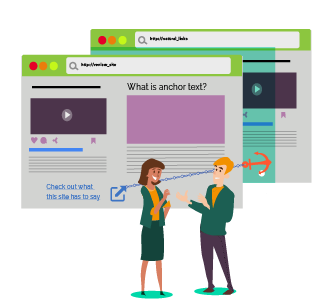Backlinks are the incoming links – or ‘inbound’ links as they’re commonly referred to – that connect an external webpage to yours.
These hyperlinks typically come from websites of similar interest to yours, who produce content that’s related to your niche.
And so, they usually want to share relevant content that they think their target audience would enjoy reading and find useful.
When it comes to off-page SEO, backlinks are very important. They’re the gentle nods of encouragement to search engines that tell them your content has value.
Backlinks Boost Your Rankings And Drive Traffic
It’s important that a search engine can see who is linking to you. If they see that other websites consider your content worth sharing and linking to, this signals authority. Search engines will be more inclined to include your content in search engine results pages (SERPs).
In fact, recent research found that pages in position one had an average of nearly four more backlinks than the pages in positions two-to-ten.
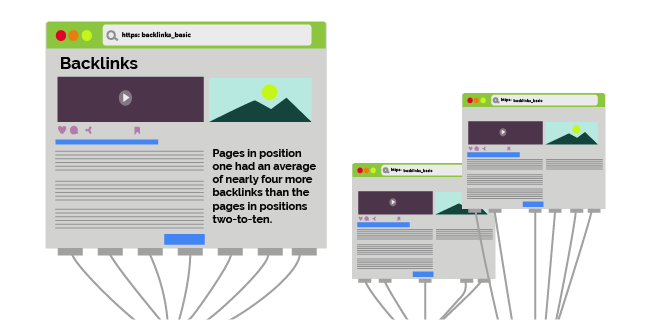
Backlinks are also a great way of driving additional traffic to your site with some external promotion.
But of course, to get your content shared in the first place, you need to build a reputation for yourself. Give your brand more exposure and prove to other sites, and searchers, that you’re a voice worth listening to.
Build connections to obtain backlinks
That means, if you’re just at the start of your SEO strategy, you’ll need to put in a lot of effort into forging these connections with reputable sites and obtain your backlinks.
In this article, I’ll walk you through the basics of backlinking. And how you can work towards gaining backlinks.
Always remember, quality over quantity
Backlinking is an important part of SEO, but you need to be mindful as you begin to build links.
It may seem appealing to try and get as many inbound links as possible, but this could cause more harm than good.
A few years ago, there were a number of black-hat techniques used by marketers. These included spamming, buying links and link farming, which artificially inflated a website’s rankings.
Unsurprisingly, these websites made for a terrible user experience. As searchers would be directed to web pages that contained a lot of gibberish text and spam links.
Search engines such as Google soon caught hold of this, and since then, have updated their algorithms to prevent these spam websites from ranking.
Today, Google now takes into account a page’s relevancy, trustworthiness and domain rating. And they will prioritise sites with fewer high quality links over those with lots of weaker backlinks.
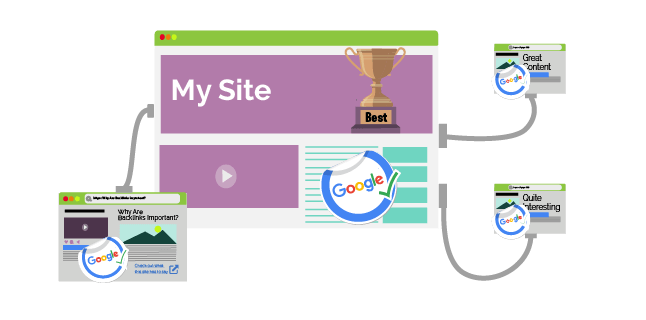
So, never try to use any shortcuts or quick campaigns for the sole purpose of gaining links. You want to create a natural backlinking profile that doesn’t contain any harmful or spam websites.
Checking for domain authority
The SEO blog site Moz has created a free search engine extension called ‘MozBar‘. You can install it to your web browser for ease.
It will tell you a site’s domain and that specific page’s authority. That way you will know whether that page is worth trying to gain a link from.
There are also a few other tools out there, such as Ahrefs or BuzzStream who can also help you check a site’s authority. We use SEMrush, for example.
Which Domains do I want backlinks from?
We recommend only trying to gain backlinks from sites with a higher DA than your website as a basic rule. That means that the higher DA your website earns, more higher domain authorities you should be targeting.
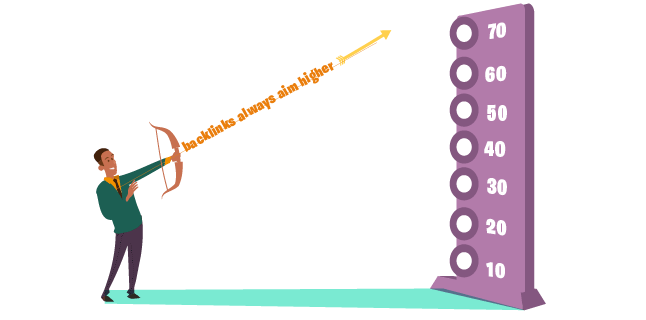
Obviously, links from domains with a high DA are worth far more than lower ones and should therefore be your priority.
But if you are starting out with your content marketing, with a new website, focusing on lower targets is fine for your first steps.
You can then build up your backlinking strategy as you get more proficient with your content marketing in general.
Types of Backlinks
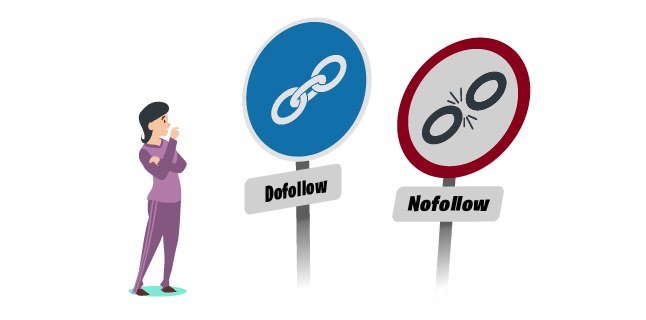
Before starting out on your link building, there are two types of backlinks you should be aware of. One carries a lot more importance than the other. These are:
Nofollow Links
If you have a backlink of particularly low quality, or a spam website is linking to you, then you probably don’t want search engines to associate you with them.
Luckily, by tagging these links with a small bit of HTML code (“rel=”nofollow”), you can tell search engines to ignore that link. These links are then removed from the indexing process, and therefore don’t impact your search engine rankings.
Dofollow Links
In contrast, if you have a quality inbound link that could help your rankings, ensure you have a ‘dofollow’ link.
These links don’t need any HTML code adding to them, but you want to ensure that the ‘nofollow’ code isn’t tagged on the link.
When the search engine bots crawl your page, they’ll take the incoming link into consideration when indexing your page. This will then boost your position in SERP rankings.
How To Start Gaining Backlinks
It’s highly unlikely that a website is going to give you a backlink for the sake of it; there’s always a higher motive at heart.

And, unless you’re one of the largest competitors in your industry, this will take time. You’ll need to reach out to external sites to promote yourself and your content.
It’s unlikely you’ll be ranking high enough at the start of your SEO journey for them to find your site organically.
Backlinking can be a time consuming process. So, you’ll need to put the work in at the start to introduce yourself to a few different websites. Then offer something meaningful in return for a backlink.
The process of gaining links is called ‘link building,’ and there are lots of different ways you can do it.
There’s no ‘one size fits all’ strategy, and so you will need to trial a few different methods to see what actions work for you.
1. Create Shareable Content
To gain backlinks from quality sites, focus on your own content first. Make sure that the content you’re putting out on your own website is high quality and shareable.
Otherwise, why would anyone have a purpose to refer their traffic there?
Content can be any kind of media on your site; blogs, infographics, videos and much more. And you want to ensure every piece of content is creating value for your site visitors.
This means, when creating your content, you want to make sure it aligns with your customer. This includes their search intents as well as the right keywords to match their queries. Most importantly, ensure your content provides genuinely relevant and helpful information in order to fulfil their search query.
You want to make sure your content is unique to that of other websites, to offer a new perspective for your visitors.
It also needs to be clearly labelled and easy to read – this is where using images can help keep it easy to filter through and break up large chunks of text.
And finally, to make your page shareable, you want to make sure your content is well-researched. Consider including some interesting statistics and infographics, so that external sites will have a reason to share your content.
As with anything in marketing, there’s no set formula for what content works best across all boards. Different searchers will respond differently to different types of media. So, you may want to incorporate a mixture into both your backlinking, and overall content marketing strategy.
2. Guest Blogging

Another way to start building backlinks with external sites is to reach out to those with blogs. Offer to write a guest post for them in your area of expertise.
Most websites will let you leave your website’s URL at the end of the article, or in a short bio about yourself. This is considered a backlink to your website.
Guest blogging is great, not only for backlinking, but for framing yourself as an authority in your industry. Give your brand more exposure by featuring on lots of related websites. And build trust and credibility in your brand as a voice in your area of expertise.
Just remember that any article ideas you pitch to another website need to be original, engaging and relevant. No one wants to read duplicated content, so always try and look for another angle.
And always remember to proof-read your work thoroughly.
Guest blogging is a chance to introduce yourself to a new audience and make an impression on them. Don’t throw it away with easy mistakes.
3. Forums

Lots of searchers visit forums like Yahoo! Answers and Quora in search of answers to their queries.
If there is a query related to your area of business, answer it. This is an opportunity for you to offer your expertise and also gain a backlink from a credible website.
Just bear in mind though, this is an opportunity to help others, and not just promote your brand. So, even though you want to include a link back to your website, ensure everything you’re writing is genuine. It should be helpful and relevant to the forum’s query and not too “sales-y”. Otherwise no one will click through to your site.
4. Reaching Out To Your Network
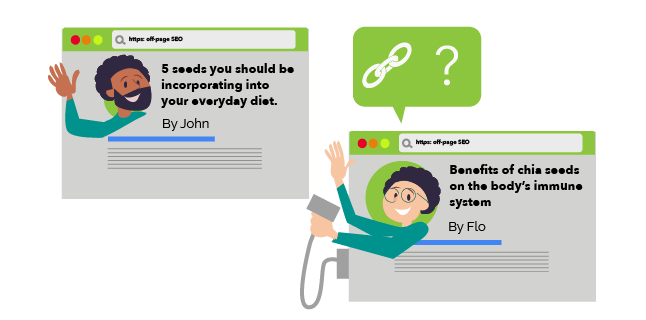
Of course, there’s nothing wrong with trying to gain backlinks simply by asking.
And, if you have a great network of connections in your industry this is a good starting point. They may be willing to write a short feature about you on your website to help you out and link to your website.
Try to connect and chat with people in your industry online, through email or LinkedIn. Or, if you attend networking events, strike up conversations with people there.
Remember, not everyone will be happy to just feature you on their site with nothing in return. You may need to repay the favour back in the future, or offer assistance on something else.
Tracking Your Backlinks
The work for backlinking doesn’t stop once you’ve agreed with a few quality websites to get an inbound link.
Backlinking is a process which needs regular check-ups. Analyse your rankings and look for new opportunities to create shareable content. It’s also important to ensure your citations are accredited. And check whether your content on other sites is still live.
There are plenty of online tools out there which will keep track of your backlinks yourself, though these can be costly, especially if you’re just starting out with your SEO.

Luckily, if your website is registered with Google, then you can easily monitor and track your backlinks yourself using Google Analytics.
With Google Analytics you can check that you have been accredited with the backlink you were promised. It shows you how many new users have arrived from these referral links.
In terms of the success of these links, Analytics does not offer a rankings index. This means you will need to monitor your those yourself.
We would suggest creating a spreadsheet where you can track your rankings overtime for the pages which have backlinks.
Summary
Inbound links are one of the most important off-page SEO strategies used to improve your rankings and site traffic.
These links need to come from quality and authoritative domains, and not spam sites, or you can harm your website.
As a small business online, you’ll begin your SEO journey with fairly low rankings. So you’ll need to put in a lot of effort at the start in order to gain exposure, and build an online reputation for your brand and website.
This means, reaching out to sites and offering to write guest blogs. Or posting in forums and reaching out to your network. And, most importantly, having a website with content that’s worth sharing in the first place!
As you start to obtain your backlinks, it’s important to always review them. Make sure you’re being properly accredited and that they’re quality. Regular review will allow you to monitor their impact on your rankings.
Of course, there are many paid tools out there that you can use to keep track of your backlinking progress. But, if you’re just starting out, you can easily monitor these inbound links yourself using analytics tools. For instance, Google Analytics.
Outsourcing Your SEO
Backlinking is just one part of off-page SEO, and there are many other factors you should consider when forming your overall marketing strategy.
To create and implement a comprehensive strategy – even just for your SEO – will take a tremendous amount of effort, and will need daily work to make it a success. Time which may be better spent working on other areas of your business.
If you don’t have the capacity or resources to dedicate to your SEO strategy, then using a marketing consultant like myself may be a great option.
How a marketing consultant can help
My team and I will work in line with your business goals, and create and implement a bespoke SEO strategy.
We have worked with lots of businesses in the past to improve their rankings, increase their conversions and revenue. And we would be more than happy to help you reach the rankings you want.
If this sounds like something you may be interested in, why not get in contact today for an obligation-free chat. I’d be happy to walk you through some of our previous work, and find out more about you and your business.





